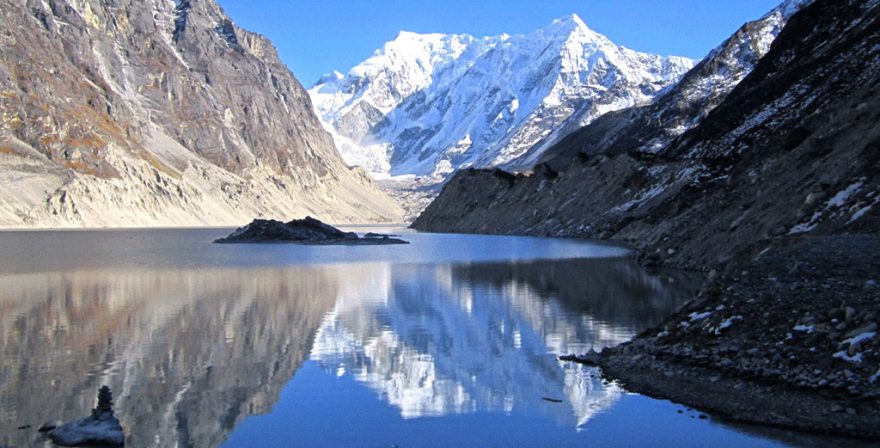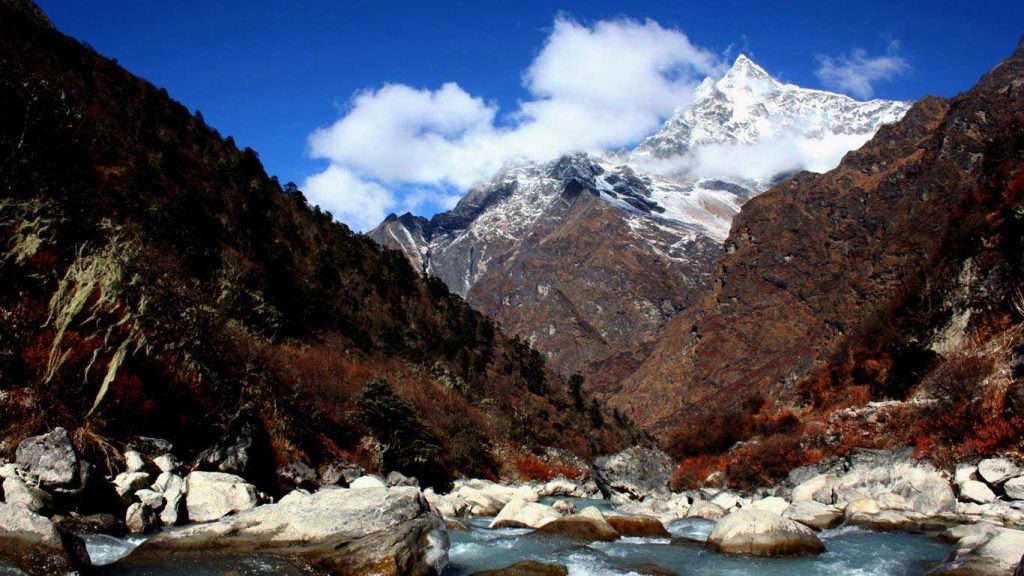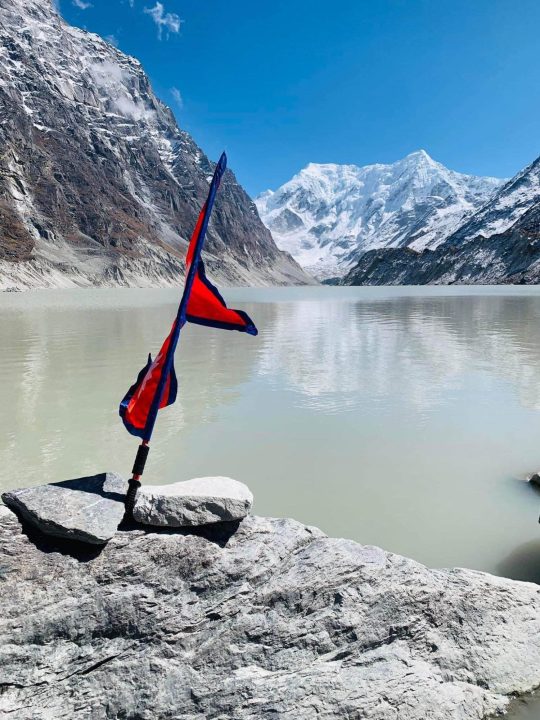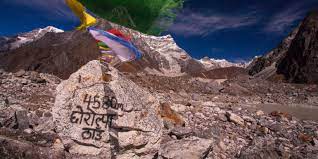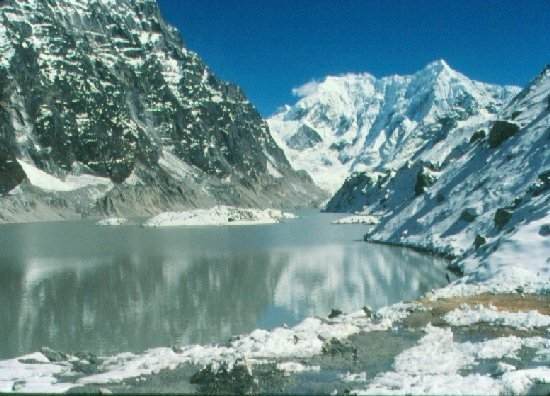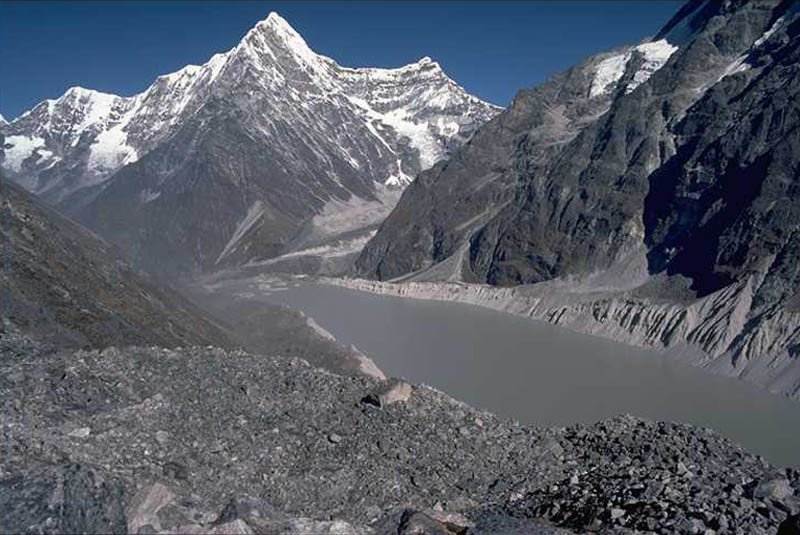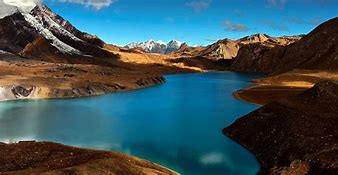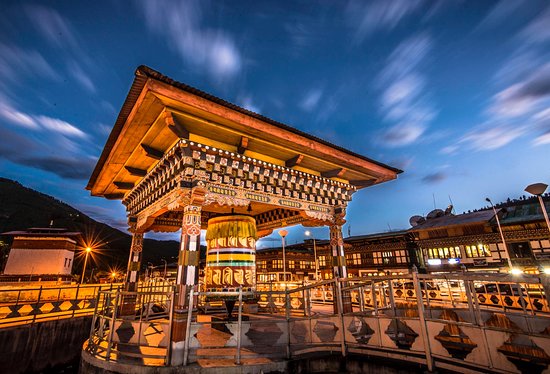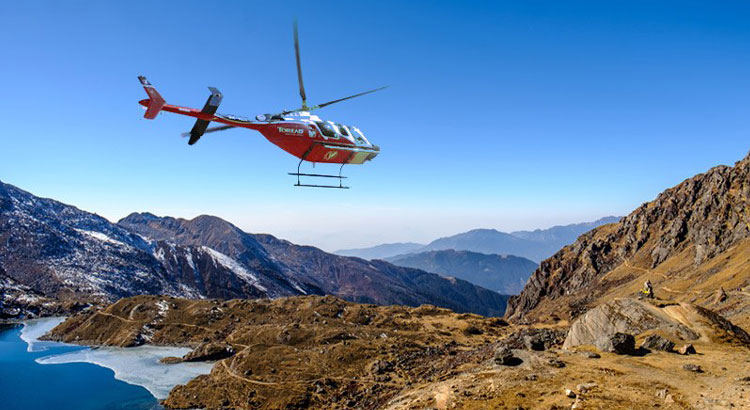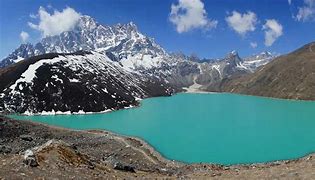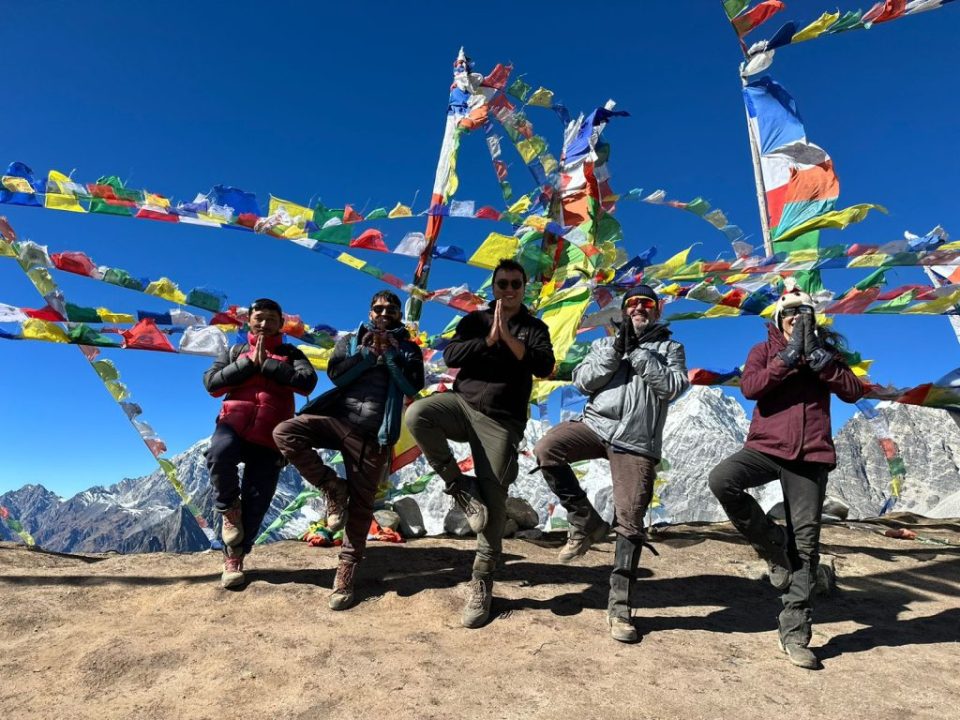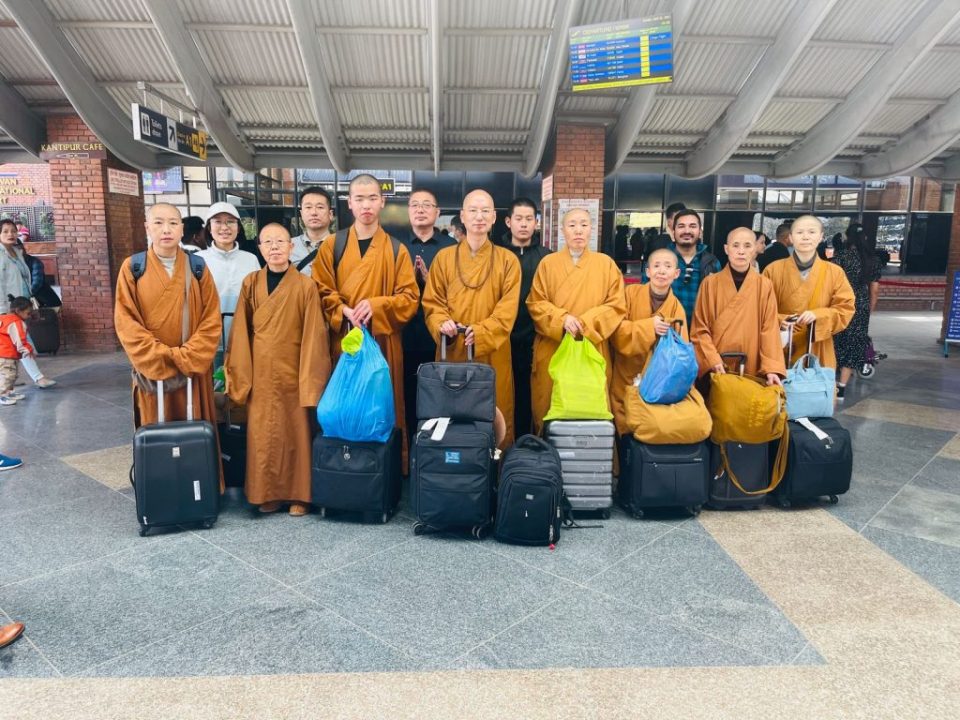Tsho Rolpa Rolwaling valley Trek – 10 Days
Trip Introduction
The largest lake of Nepal Tsho Rolpa is located in Rolwaling valley, Dolakha District at an altitude of 4,580m/ 15,030 ft. It is also the part of “Gaurisankar Conservation Area project (GCAP)”. The Rolwaling area is located between the Langtang and Everest ranges. Rolwaling is a steep Himalayan valley protected by Gaurishankar’s snow peak. Because of its remoteness, the Rolwaling valley is renowned as “the Grave”. It is unspoiled Trekking Trail.
Tsho Rolpa Lake, the trek’s highlight, is located between tiny hills and the surrounding mountains, creating a unique view. The calm atmosphere surrounding the lake also makes the journey worthwhile. Because the path leads you near the Tibetan border, there is a strong Buddhist influence in the area. However, you may witness Brahmin, Chhetri, and Sherpa culture and lifestyle. The trip offers trekkers to experience the Rolwaling valley’s Sherpa culture as it passes through communities like as Chhetchhet and Beding. The path is primarily made up of waterfalls, rivers, Mani walls, rice fields, and meadows that all work together to make the walk unforgettable.
Your 10-day Tsho rolpa trek will begin with a journey from Kathmandu to Simi Gaun. The drive will take between 7 to 8 hours. Simigaun is the starting point for your trek to Tsho Rolpa. The Rolwaling walk goes up along the Upper Tama Koshi river bank, providing views of the Mountains River. We will pass through Sherpa, Tamang, and Chhetri communities, experiencing their traditional ways of life. You will be rewarded with breath-taking views of Gaurishankar Himal as you travel through the small settlements of Rolwaling valley. Although the remote hike to Tsho Rolpa Lake is challenging, it is filled with stunning natural features that make the trek worthwhile.
Trip Facts
|
Country |
Nepal |
|
Region |
Rolwaling |
|
Duration |
10Days |
|
Highest Elevation |
4,580m / 15,030ft |
|
Grade |
Moderate to Difficult |
|
Meals |
Breakfast, Lunch and Dinner |
|
Accommodation |
Hotel, Lodge and Tea Houses |
|
Best season |
Mar, Apr, May, Sep, Oct, Nov |
Trip Highlights
-
Enjoy the stunning view of the high altitude Tsho Rolpa lake.
-
Experience the amazing views of Gaurishankar Himal.
-
Walk on less crowded paths and quiet surroundings.
-
Enjoy the view of Snow-covered soaring high Himalayan peaks in the distance.
-
Explore the gorgeous and isolated Beding and Naa village.
Is this Trek Appropriate for You?
-
The Tsho rolpa Trek is the Difficult trek. You can easily complete this trek if you are physically and mentally prepared and willing to do so.
-
You will be Trekking for 6 Days. The Path can be Completed in as little as 2 hours as much as 8 hours.
-
The walk is not tricky, there is no Climbing or Scrambling but the path is rocky and hilly.
-
Each day you will cover 200 to 400 meters in height while trekking. Highest point in trek you will reach on the trek is 4,580m.
-
The weather and remoteness of this trek, as well as dealing with the high altitude, require a slow pace and the need to stay hydrated.
Itinerary
|
Days |
Activities |
Durations |
|
|
Arrival at TIA, Kathmandu (1400m/ 4,595ft) |
|
|
|
Drive to Chetchet and Hike to Simi gaun (2,019m/ 6,625ft) |
10 hrs |
|
|
Trek from Simi gaun to Dongang (2,800m/ 9,190ft) |
6-7 hrs |
|
|
Trek from Dongang to Beding (3,690m/ 12,100ft) |
4-5 hrs |
|
|
Trek from Beding to Naa (4,183m/13,725ft) and Hike to Tsho Rolpa (4,580m/ 15,030ft) |
4-5 hrs |
|
|
Trek from Naa to Donang (2,800m/ 9,190ft) |
6-7 hrs |
|
|
Trek from Donang to Simigaun (2,019m/ 6,625ft) |
6-7 hrs |
|
|
Hike from Simigaun to Chetchet and Drive to Kathmandu (1400m/ 4,595ft) |
10 hrs |
|
|
Rest Day at Kathmandu (1400m/ 4,595ft) |
|
|
|
Departure |
Itinerary
Departure from : Kathmandu, Nepal
Arrival On : Kathmandu, Nepal
Day 1
Arrival at TIA Kathmandu
Once you arrive at the international airport of Kathmandu A friendly smile will greet you. Our agent will pick you up from the airport and transport you to your accommodation. Arrive at the hotel and check in. Our guide will meet you in the evening and give you a quick overview of the journey. Dinner and Overnight stay at the hotel.
Day 2
Drive to Chetchet and Hike to Simi gaun
The first day of your trek will include of a private vehicle ride from Kathmandu to Chet Chet. The journey will last 7 to 8 hours. The route will be Kathmandu-Dhulikhel-Mude-Dolkha-Bhimsen-Singati-Jagat-Chetchet. Lunch will be on Mude. After arriving at Chetchet, you will relax for 15 minutes before hiking to Simigaun. You will walk in the stairs all the way to Simigaun. Hike to Simigaun will take around 2 hours due to the steepness of the route. Dinner and Overnight stay at the Lodge.
Day 3
Trek from Simi gaun to Dongang
Today, after breakfast, you will depart from Simi Gaun. The track is easy to follow, with just moderate ascents and descents. We take a break at the village of Uttise. Surmuche arrives a little more than an hour after Uttise. Surmuche is reached through a steady ascent. We’ll stop at Surmuche for lunch. We’ll leave for Donang after nearly an hour of relaxation. After lunch, it’s another hour to Kyalche, where there’s a lovely teahouse. In Kyalche, we will have a 15-minute break. You will walk for 40 minutes from Kyalche to Donang. Dongang’s village consists of only two teahouses. Overnight at Dinner at the Lodge.
Day 4
Trek from Dongang to Beding
After breakfast, you will depart for Beding. You’ll be walking for 4 to 5 hours. The trek to Thangding is breath-taking. There appears to be a mountain view in nearly every direction. After about 2 hours of trekking, you will arrive at Thangding for lunch. You will cross a sacred temple shortly after leaving Thangding. According to locals, a cow gave birth to a god here. Throughout the hike, you will pass by many waterfalls and hike alongside Rowaling Khola.Beding has two monasteries and is a fairly large village. An ancient monastery built into the rocks was sealed after the earthquake. Regardless, you can still hike up there. You may go to the second, newer monastery, which is right beside the river. You will be staying in Beding for the night.
Day 5
Trek from Beding to Naa and Hike to Tsho Rolpa
After breakfast, depart for Naa village. You will be hiking for around 2 hours. You should walk gently as you gain elevation and keep hydrated the entire time. The trek from Beding to Na is breath-taking. There are numerous spectacular waterfalls and another monastery built into the mountainside. When you arrive in Naa, put your belongings at the lodge and set off towards Tsho Rolpa with a small pack including a water bottle and food. You’ll be hiking for roughly 2 hours from Naa to Tsho Rolapa. The trek from Na to Tsho Rolpa Lake is short but strenuous. The walk begins easy and straight, but just before the lake, it transforms into a steep stairway that goes straight up. When you get at the lake, you will be fascinated by its milky glacier lake. You can relax and enjoy the scenery because it is peaceful. You may have your snacks while admiring the lovely photos. You’ll go back to Naa for lunch. You may hike to Dudh Kunda, which is 3 hours away from Naa village but due to the lack of a reliable trail it is difficult to access. Dinner and Overnight stay at the Lodge.
Day 6
Trek from Na to Donang
After a hearty breakfast, depart Naa for the Bheding, returning by the same path. Have a satisfying lunch in Bheding before departing for Thangding. Throughout the journey, you will be surrounded by stunning scenery. You’ll be walking for 6 to 7 hours today. After reaching Thangding, take a short stop for refreshments before continuing on to Donang, which is about a 2-hour walk. Dinner and overnight at the Lodge.
Day 7
Trek from Donang to Simigaun
After breakfast in Donang, depart for Simigaun. The route is full with water falls and wooden bridges that will keep you entertained the entire way. We will arrive at Kyalche, relax for a little, and then go for Surmuche, where we will have lunch. We’ll head for Simigaun after a great meal. You will be walking for 6 to 7 hours in total. Dinner and overnight at the Lodge.
Day 8
Hike from Simigaun to Chetchet and Drive to Kathmandu
After breakfast at Simigaun, hike for 2 hours down to Chetchet, where your vehicle will be waiting for you. You’ll be departing for Kathmandu today. The journey will take 7 to 8hours. On the way, you’ll have your lunch. Dinner and Overnight at the Hotel.
Day 9
Rest Day at Kathmandu
At the Kathmandu Durbar Square, you will be enjoying a delicious breakfast. The remaining of the day is yours to design according to your preferences. You may go shopping or visit one of Kathmandu’s three durbars. Swyambhunath or Bouddhanath can also be visited in the evening for the evening prayer. Go to a Pasupathinath for “Sandhya aarti,” also known as Night aarti, at night. Following that, have a farewell dinner with your teammates. Dinner and Overnight at the Hotel.
Day 10
Departure
Today you will be leaving for your home. Our representative will drop you at the airport three hours before your flight’s departure time.
Route Map
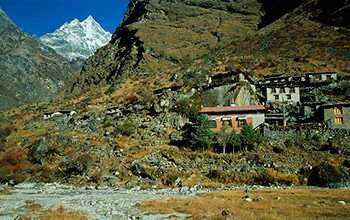
Altitude Map
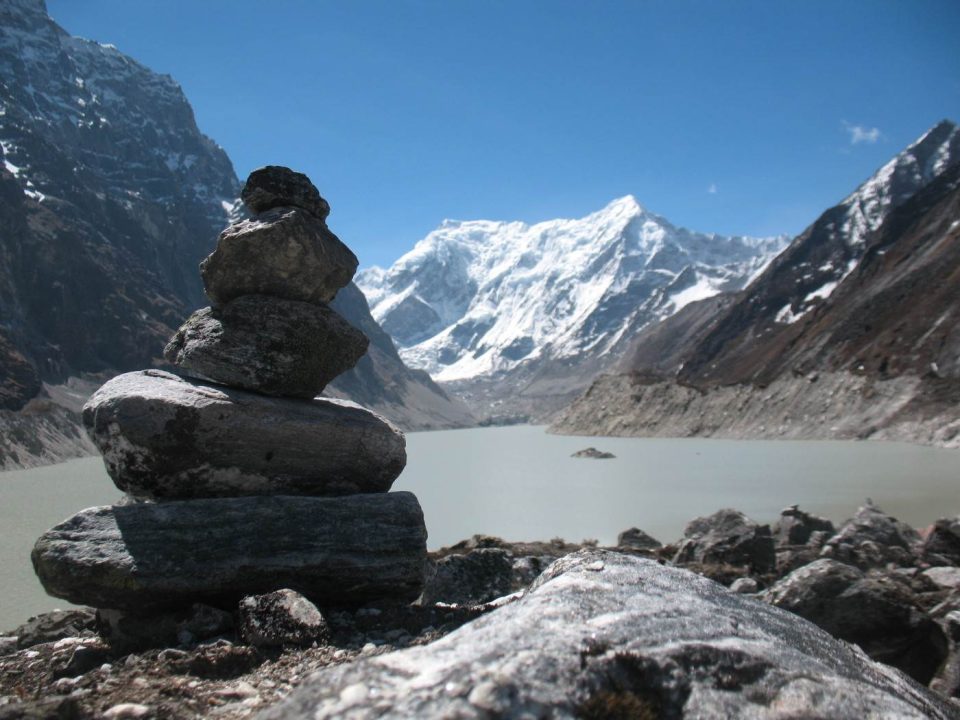
What's Included
-
Arrival & Departure: Airport – Hotel transfer – Airport (Pick Up and Drop on private basis).
-
Hotel Accommodation in Kathmandu: 2nights at Star categories hotel on twin sharing on BB basis.
-
Welcome Dinner and farewell dinner at Nepali culture restaurant in Kathmandu with Office’s Staffs.
-
All government and local taxes if necessary.
-
Permits: All necessary paper works: Gauri Sankar Conservation Area permit (GCAP), TIMS Cards.
-
Insurance: Insurance for all involved Nepalese staffs during the trek.
-
Trekking Map: Rolwaling Region Trekking map.
-
Member transportation: – Road Transportation: Drive from Kathmandu – Chetchet and while returning to Kathmandu from Chetchet on private basis.
-
Food & Lodging: 3 meals a day (Breakfast, Lunch, Dinner) along with accessible accommodation sharing at Lodge during the trek.
-
Drinking: 2 liters boiled water to carry on thermos per day per member.
-
Guide: Government licensed Guide (English speaking) during the trek
-
Porter: Porters (2 trekkers: 1 porter) up to 15kg during the trek.
-
Insurance of guide and potter.
-
Comprehensive Medical kit.
What's Not Included
-
Air Fare: International flight airfare (from and to Kathmandu).
-
Nepal Tourist Visa fee.
-
Extra night in Kathmandu: Extra nights’ accommodation in Kathmandu. In case of early arrival or late departure, early return from Trekking (due to any reason) than the scheduled itinerary.
-
Personal Insurance: Travel and high-altitude insurance, accident, Helicopter medical & emergency evacuation. *Mandatory
-
Rescue Evacuation: Medical and emergency rescue evacuation cost if required. (Rescue, Repatriation, Helicopter, Medication, Medical Tests and Hospitalization costs).
-
Personal Expenses: Telephone calls, Internet, Toiletries, battery recharge, hot shower, laundry, soft drinks, beer and any alcoholic beverages.
-
Personal Equipment: Clothing, Packing Items or Bags, Personal Medical Kit, Personal Trekking equipment.
-
$ USD for extra per porter per day (If extra porter demanded).
Equipment List
What to bring ?
General
Tailor Your Holiday
Everyone has their own preferences in terms of destination, journey time, and budget. As a result, sticking to our plan isn't necessary. We will create a personalized itinerary for you that includes accommodations, transportation, meals, and tour guides. We guarantee you the best Tailor-made Package because this is your trip. You have the option to personalize it, as your liking. Let us Plan together to make your Vacation worth it.
Fixed Departure
Why Travel With Us?
Secure Online Payment, No Credit Card Fee
Travel with Locals. Support Locals
Lifetime Deposit
Private & Tailor-Made Trips
24/7 International Support
Support Local Communities & Donate to Charity
All Inclusive Price
Secure Online Payment, No Credit Card Fee
The ideal season to travel
Spring (March, April, May): The weather warms up in the spring, and the winter snows begin to melt. Trekking is a wonderful option in March. Wildflowers such as Rhododendron bloom all over the hills, transforming the landscape into a colourful paradise. There are more blooms and the vegetation is greener.
Summer (June, July, August): Monsoon starts at the eastern end of the Himalayas, starting from the Bay of Bengal. During the monsoon in Nepal, we do not organize any trekking. Landslides and rocks make driving on highways and walking on the paths dangerous. The monsoon rain affects this season, even though it is the warmest of the year.
Autumn (September, October, November): The autumn is the greatest time for the Tsho Rolpa walk because the weather is clear and the trail is dry. Wildflowers such as Rhododendron flourish throughout the slopes, converting the hills into a colourful paradise. Mountain views are crystal clear, and this is the perfect moment to shoot them.
Winter (December, January, February): It is possible to trek in Tsho Rolpa during the winter, but your trek may be affected by heavy snowfall, therefore you must be properly equipped and plan wisely for this trek.
Drive to Chetchet
-
The distance between Kathmandu and Chetchet is 200 kilometers.
-
It takes around 7 to 8 hours to travel by private jeep, and approximately 9 to 10 hours to travel by public bus.
-
The route to Rolwaling valley is same either way, Kathmandu-Dhulikhel- Mude-Dolkha – Bhimsen – Singati – Jagat – Chetchet .
-
To drive from a private jeep, you must depart early at 7:00 a.m., as the jeep will arrive at your hotel to pick you up.
-
To drive in a public bus, you must leave early in order to catch a bus at either 6:00 a.m. or 8:00 a.m. from Ratna Park. you must arrive early and reserve your seat.
Altitude sickness
Beyond 2500m (8000ft), Altitude sickness is a sneaky monster that may attack even the fittest trekkers. These demands doing everything in your power to prepare for altitude trekking and taking things carefully throughout your Rolwaling region journey. With increasing altitude, the amount of available oxygen decreases, which is the primary cause of high-altitude sickness.
Tsho Rolpa lake is located in 4,580m above sea level. There is high chance if occurring altitude sickness from Beding. You may suffer from different altitude sickness in the altitude of 4,580m (Tsho Rolpa lake) i.e., Acute Mountain sickness (AMS), High pulmonary edema (HAPE), High-altitude cerebral edema. So, it is very important to know everything about the altitude sickness. Your body requires time to adjust to thin air, so start at a lower altitude and work your way up. Some of the symptoms of Altitude sickness are:
-
Increased breathing.
-
Increased urination.
-
Restless sleep.
-
Periodic breathing at night because of altitude.
-
Dehydration.
-
Shortness of breath.
-
Extreme fatigue.
-
Respiratory failure.
-
Cerebral edema.
-
Coma.
Certain care should be made to ensure that the situation does not worsen. However, if the symptoms worsen, you may need to return to a lower height and seek medical help. There are, however, several other precautions you may take while trekking in the Rolwaling region to lessen your risk of altitude sickness.
-
Trekkers can modify their bodies by slowly and gradually climbing, as our bodies require time to adjust to the oxygen level. At least one day of acclimatization rest is required for high altitude trekking, and you should go as high as possible before returning to a lower height for the night.
-
You should do various strength training exercises such as running, cycling, jogging, push-ups and going to the gym to acquire strength and stamina for your adventure.
-
As the air gets increasingly thin, an increase in elevation reduces oxygen levels, and in the Everest region trek, an increase in altitude also means less vegetation. The consumption of alcoholic beverages, cigarettes, and tobacco decreases the body’s water content.
-
The greatest remedy is to always stay hydrated. On your walk, instead of drinking cooled water, drink warm water.
-
Diamox is the most effective altitude sickness medication; thus, you should bring a subscription with you on the trek. However, you should consult with your physician to see whether it is advantageous.
So, here you have it: everything you need to know about altitude sickness before trekking to Tsho Rolpa. Please contact us if you have any questions.
Things to known before travelling to Rolwaling valley
Drinking Water
Especially for trekkers, it is very necessary to hydrate your body at a higher altitude than in lower elevations to avoid dehydration and altitude sickness. Lack of fluid can be the main hindrance during the trek. You should hydrate your body with at least 3-4 liters of water on a daily basis (Tea, soup, or normal drinking water).
Rowaling valley is one of Nepal’s most remote valleys having very little human settlement. Simigaun and Beding are the only two places where there is a large human settlement. There are only one or two houses in Uttise, Surmuche, Kyalcha, Dognang, Thakding, and Naa for tourists to stay, eat, and rest. Other than this, there isn’t even a single settlement within the distance of 5km (around 3hrs) from one destination to another. As a result, getting drinking water on the way to Tso Rolpa will be extremely difficult.
Throughout the trek, the only places to get drinking water are teahouses and lodges, but it is not safe to drink without purifying it. Sealed bottle water is also not available throughout the trail. Therefore, we recommend you to bring a Reusable water bottle of 2-3ltr or water pouch favorable for both hot and cold water.
During this trek you may have to pay between 1$ to 5$ for a sealed bottle of water.
Here are some ways that you can use to make the water drinkable.
1. Boiled water
Boiling water is the best way to purify the water. As we are climbing to a higher altitude you need to boil the water for about 3-minute and season it with a pinch of salt before drinking. You can get free tap water in the teahouse but for boiled water, it cost around 1-2$ per liter and 3$- 10$ for large pot.
2. Purification tablets or electrolyte powder.
Purification tablets like chlorine or iodine tablets are commonly used tablets by trekkers to disinfect the water. 1 tablet is enough for a liter of water. It takes around 30 min for the tablets to dissolve and become drinkable. Water purify by tablets may leave a taste in your mouth.
Electrolyte powder is another option. Electrolyte powder is a better way to purify water than tablets because electrolyte powder contains minerals such as salt, Potassium, Magnesium, which are important for your body during the trek.
3. UV Light water purifier/ SteriPEN.
It is a simple, effective, economic and environment-friendly way to purify water. It kills the bacteria and virus within 10 sec by exposing them to ultraviolent light using Steripen, without changing the flavor of water. This is the highly recommended method of purifying water.
Electricity and Internet facility at Rolwaling valley.
Electricity facility.
Rolwaling valley is one of the remote areas of Nepal. There is no access to electricity. The entire valley relies on solar power electricity, which is only enough to light a bulb. There is no charging socket in your room. Even if you are wiling pay for charging, your device will not be able to charge with the solar power. You can charge your device in Chetchet, which is both the beginning and end point of our trek. As a result, it is recommended that you bring a power bank that will last the duration of your trek.
Recently a new hydropower project has been proposed near the Rolwaling valley, and an electricity pole has been installed. So, within few years Rolwaling valley will have access to electricity.
Internet Facility and Service
Internet and network facility is needed to contact your family, friends, employee, to post updates and upload photos during the trek.
Rolwaling Valley has no internet service because there is no electricity.
NTC cellular service has been providing the GSM mobile network service in Rolwaling valley all the way up to Tsho Rolpa. You can buy the NTC sim card from the stores in Kathmandu for 1$. By taking data packages you can access the internet from NTC up to Tsho Rolpa only when mobile network catches a signal. It is not guaranteed that your mobile network will catch the signal throughout Rolwaling valley.
|
Buy NTC data package Dial*1415# |
Cost of data package in NTC: –14GB=7$ (Valid up to 28days -30GB=15$ (Valid up to 90 days) |
Check balance Dial *1415# |
Document needed to buy a sim card.
For foreigner = 1 passport size photo, Passport photocopy, or valid identity card.
For Nepali = 1 Passport size Photo, Photocopy of Citizenship.
Some useful tips to save the battery.
-
Extra batteries for the camera.
-
Power bank with 5000-10000mAh.
-
The solar charger and solar lamp (LuminAID Nepal lamp)
-
As possible less usage of a device with low brightness, GPS, and airplane mode.
Essential Backpack items for Tsho Rolpa Trek.
The bag of a trekker also reveals the trekker’s level of experience. A good trekker should be a smart backpacker. You should be pre-prepared for the things that you need in the trek. As this trek is in a remote valley, there is no shops once you leave the road, so need to bring enough supplies that you need in the trek.
Here are some of the things that you need to take with you for the trek.
Travel documents
-
Airline tickets with the itinerary.
-
Travel insurance policy documents.
-
Valid passport.
-
Copies of passport.
-
Passport-sized photos.
-
Nepalese cash.
-
Travel permits.
Clothing
-
A pair of waterproof trekking shoes or hiking boots.
-
A pair of flip flop slippers or running shoes.
-
2 sets of thermals (leggings and tops)
-
3-4 pairs of hiking long sleeve shirts or tops.
-
Pairs of hiking shorts and pants.
-
Fleece jumpers or a set of tracksuits.
-
Good quality windproof down jacket.
-
Lightweight waterproof rain jacket and pants.
-
Neck gaiter, leg warmer, and packet of pocket hand warmers.
-
4-5 pairs of quick-dry socks, underwear, sports bra.
-
Pair of inner and outer gloves.
-
Knitted Hat, sun cap, beanie, or bandana.
-
Glacier Sunglasses and eyeshade.
Trekking equipment
-
Waterproof trekking bag of 40-50liter and Rucksack of duffel bag (if your backpack is not enough for all your item and need a potter).
-
Reusable water bottle (both hot and cold) of at least 2-3litre.
-
A sleeping bag and sleeping bag liner.
-
Trekking stick/ poles.
-
Map of Rolwaling region.
-
Crampons (if you are trekking in Winter season, Dec-Feb).
-
LED Headtorch or solar lamp (LuminAID Nepal lamp is best as it solar charged and very much portable)
-
Stuff sacks, plastic bags.
-
Plug adapter, Charging appliances, power bank, batteries.
-
Pocket knife.
-
Travel Wallet.
Toiletries
-
Rolls of Toilet paper, wet wipes, and tissue.
-
Medium-sized quick-drying towel.
-
Toothbrush and toothpaste.
-
Hand sanitizer.
-
Sunscreen, lip balm, body lotions.
-
Deodorants.
-
Portable mirror.
-
Shampoo and soap.
Personal First Aid Kit
-
Antibiotics
-
Painkillers, Paracetamol, ibuprofen, aspirin, Nicole
-
Sanitary pads
-
Bandage.
-
Anti-inflammatory spray.
-
Anti-Nausea tablets.
-
Anti-diarrhea pills or power.
-
Altitude sickness tablets- Diamox
-
Water purifying tablets or electrolyte powder.
-
Mosquito and Insect Repellent.
-
Salt or anti leech oil (If travelling in rainy season, July- Aug)
-
Earplugs
You can buy or hire trekking cloths and equipment in Kathmandu. If you are buying it, you have to allow an extra day for shopping; however, if you are hiring it, you must inform us in advance so that we can arrange it before your arrival in Kathmandu. This way you can reduce the weight of your luggage and save time and money.
Branded trekking clothes and equipment are available around Thamel area in a reasonable price.
Accommodation, Meal, and Transportation
Accommodation
We will accommodate in star hotel during our stay in Kathmandu.
For our stay from Chetchet until returning back to Chetchet we will accommodate in lodges. There is no human settlement except in Simigaun, Dognang, Beding and Na which is our destination to stay for overnight.
During the trek, we will provide you three-time meals. You can choose from the given menu.
Breakfast– Pancakes, Bread butter, fry or boiled eggs, Tsampa porridge, Butter tea etc.
Lunch– Dal Bhaat (Rice, Vegetable curry, Meat curry, Lentils, Gundruk Chutney) Vegetable noodle soup, Chicken soup, Garlic soup, Fried rice, Fried noodles, Mo: Mo etc.
Dinner– Dal Bhaat (Rice, vegetable curry, meat curry, Lentils, Gundruk Chutney),Vegetable noodle soup, Chicken soup, Garlic soup, Fried rice, Fried noodles, Mo: Mo, instant noodles.
Besides these, there are a variety of other food options. You can buy from your own pocket.
Transportation
By Bus- From Kathmandu airport to hotel at Kathmandu and vice-versa.
From Kathmandu to Chetchet and vice-versa.
Guide and Staff Arrangements
Throughout the trek, all your activities will be handled by our well-qualified and professional staff. They will do all the escorting. As this is one of the hardest and tricky trek, we are providing you a highly experienced and licensed guide with fluent English speaking and has excellent navigation and technique of rope fixing skills. They will accompany you from Kathmandu and guide you all the way to Tsho Rolpa. Each group of 4-5 trekkers will be assigned an assistant guide, as well as a porter for two trekkers (2*15kg =30kg). If your luggage weight more than 15kg you will be provided a porter individually but you will be charged of 2 people.
All our lead guide, assistant guides, and potters are well professional and experienced. So, we hope for your respect and cooperation with them throughout the trek.
A typical day on the Tsho Rolpa Trek
Every day will begin with the ringing of your alarm clock at 6 a.m. and a knock on your door from your guide with the invitation of breakfast. Get up, have breakfast, pack your backpack and get ready to start your day’s walk by 7 a.m. We need to start our trek early to avoid the scorching sun as in midafternoon the wind gets stronger compared to morning in higher altitude.
You’ll wander along trail enjoying the scenery, clicking photos, creating memories, interacting with your guide, hearing each other’s stories. Lunch will be served at a local teahouse in the afternoon. Having the flavorful Nepalese Dal Bhat and an hour of rest, we will proceed to the day’s final destination as per the itinerary.
On arrival at the destination, check into your accommodation. Get freshen up and some rest. As every teahouse/lodge where we stay has a common dining area with a wood- burning stove in the center, there you will get to meet other travelers. You can sit there, laugh at each other stories, play cards, sing songs, play music, and have a good time. This will help you forgot all the tiredness of the day. Later at the evening you will have your dinner together. After dinner, your guide will give some short briefing about next day’s trek regarding when you must get up, when we have to start our trek next day, where we will stay the next day, how many hours we have to walk and so on.
During your 7-8hrs drive from Kathmandu to Chetchet enjoy the mountain ranges and landscape from the window of jeep. You will be walking for a maximum of 7hrs to minimum of 4hrs per day. The whole trek is steep. Mt. Gauri Shankar will be your constant compansion throughout the trek. The entire trek is a peaceful walk-through nature. When you reach Tsho Rolpa you will be fascinated by its milky glacier lake. You will get to experience the isolated village of Beding and Naa.
Every stop in the Rolwaling valley might not offer you scenic view but will definitely offer you a peaceful environment. Your hard walk will be paid off on reaching the final destination with lifelong memories.
Nepal Tourist Visa and permits details
Visa procedure.
To travel Nepal, you’ll need a tourist visa that is valid for the period of your stay in Nepal. Better, if you have a tourist visa valid for at least 1 months because anything can happen during the trip and staying in Nepal after your visa expires would result in you paying a penalty. Apply for a visa at your nearest Embassy of Nepal or obtain an Arrival visa at immigration in Tribhuvan International Airport, Kathmandu. But it’s better to contact your nearest Nepalese Embassy.
Here are the documents that you need, to apply for the tourist visa.
-
The Tourist Visa Application Form for Nepal (Fully completed online and printed)
-
Original Passport with at least 2 blank pages and validity of at least 6 months.
-
Photocopies of your passport’s personal information page.
-
At least 2 recent passport-sized photos of yourself with white background.
-
Proof of accommodation in Nepal.
-
Valid travel and return flight tickets.
-
A bank statement from the last 3 months with a minimum closing balance of NPR2,00,000.
Note: Our trip is of 10 days so apply for 15 days visa, costs USD 30. But if you want to spend more time on your own in Nepal, apply for 30 days tourist visa that costs USD 50. For 90 days visa, costs USD125.
Entry permits and Requirements
You have to show these permits in the small office just before the bridge in Singati to enter the Rolwaling valley. The Entry permits that you need for the trekking to Tso Rolpa are;
|
Trekking permits |
Foreign Nationals |
SAARC Nationals |
Nepali Citizens |
|
|
1. |
Gaurishankar Conservation Area Permit |
NPR 3,000 per person per entry |
NPR 1,000 per person per entry |
NPR 100 per person per entry |
|
2 |
Trekker’s Information Management System (TIMS Card) |
NPR 1,000 per person with a guide (GT) and NPR 2,000 for solo trekkers (FIT) |
NPR 300 per person with a guide (GT) and NPR 600 for solo trekkers (FIT) |
-N/A |
Note-Get Gaurishankar Conservation area permit and TIMS Card from Nepal tourism board, Bhirkuti Mandap, Kathmandu. Rolwaling valley restricted area permit is commonly known as TIMS Card, so not to get confused in these two permits.
For the issue of TIMS Card, you need at least 2 members, accompanied by a licensed guide.
For more information about TIMS Card here the link.
(If you are travelling from travel/trekking agency your agency will arrange all the Permits.)
Documents required to get these permits.
-
Complete the permit form with your passport details and tour details (Trekking area, Entry and Exit date and point, Route of Trekking, Emergency contact information for Nepal and your Home country).
-
4 Passport size photo.
-
4 Photocopies of passport personal information page.
-
Copy of Travel Insurance policy to obtain TIMS card.
Travel Insurance
During the journey, you may encounter a number of unexpected incidents or losses. Trekking in Nepal is an adventurous and occasionally dangerous activity, especially at high altitudes. Trekkers must have travel insurance before visiting Nepal for trekking. During this 10-days trek to Tsho Rolpa you may encounter a physical injury, illness or an unexpected accident, and you will be responsible for all medical expenses and losses.
Choose an insurance policy that cover all of your possible risks from the start of your journey to your final destination. The following threats should be covered by your travel insurance:
-
Cancellation of Domestic and International flights.
-
Lost and stolen of baggage and passport.
-
Hospital and Medical expenses (physical injury, Acute Mountain sickness, Altitude sickness, sudden accident)
-
Emergency rescue such as Helicopter.
-
All high-altitude trek dangers up to 4,600m.
You need to choose your travel insurance wisely so that, in the case of such incident, your travel insurance will cover the costs.
You can get your travel insurance in either your home country or Nepal.
Responsible Travel
Rolwaling valley is the virgin tourist destination of Nepal. The village in Rolwaling valley is isolated and soaked in culture. You will be able to experience the typically lifestyle of Chettri, Gurung, and Sherpa that have been living in this area for a long time. This is the valley with the least amount of human settlement.
So, you have to respect the local people, their local culture and tradition as well as nature and environment. You can help them by using local products and services. You can learn some Nepali greetings words to greet them respectfully.
While walking along the forest trail, you must maintain a peaceful attitude. In the forest, do not play music. It frightened the wildlife. We expect you to properly dispose your plastic garbage (food wrappers, plastic water bottles).
Rolwaling valley is a restricted area, so you must obtain permits from the Nepalese government in order to trek through it. Because it is a newly discovered trekking destination, the infrastructure in this valley is not well developed.
Your one small negative activity can make a big impact on them and their daily life.
Your responsible travel will help Nepal achieve long-term sustainable tourism.
Tsho Rolpa Rolwaling valley Trek – 10 Days
Trip Reviews
Lorem ipsum dolor sit amet, consectetur adipisicing elit, sed do eiusmod tempor


